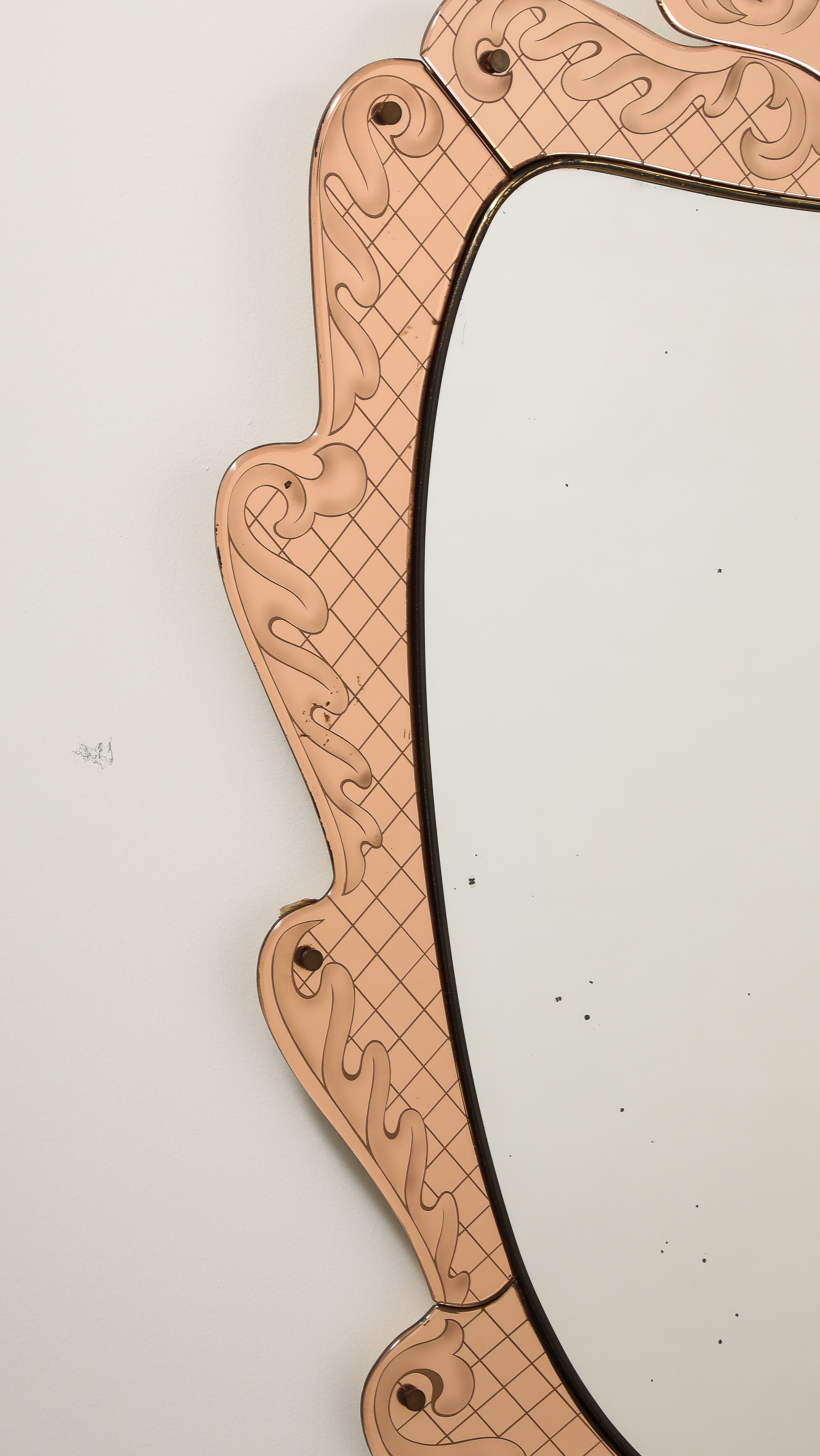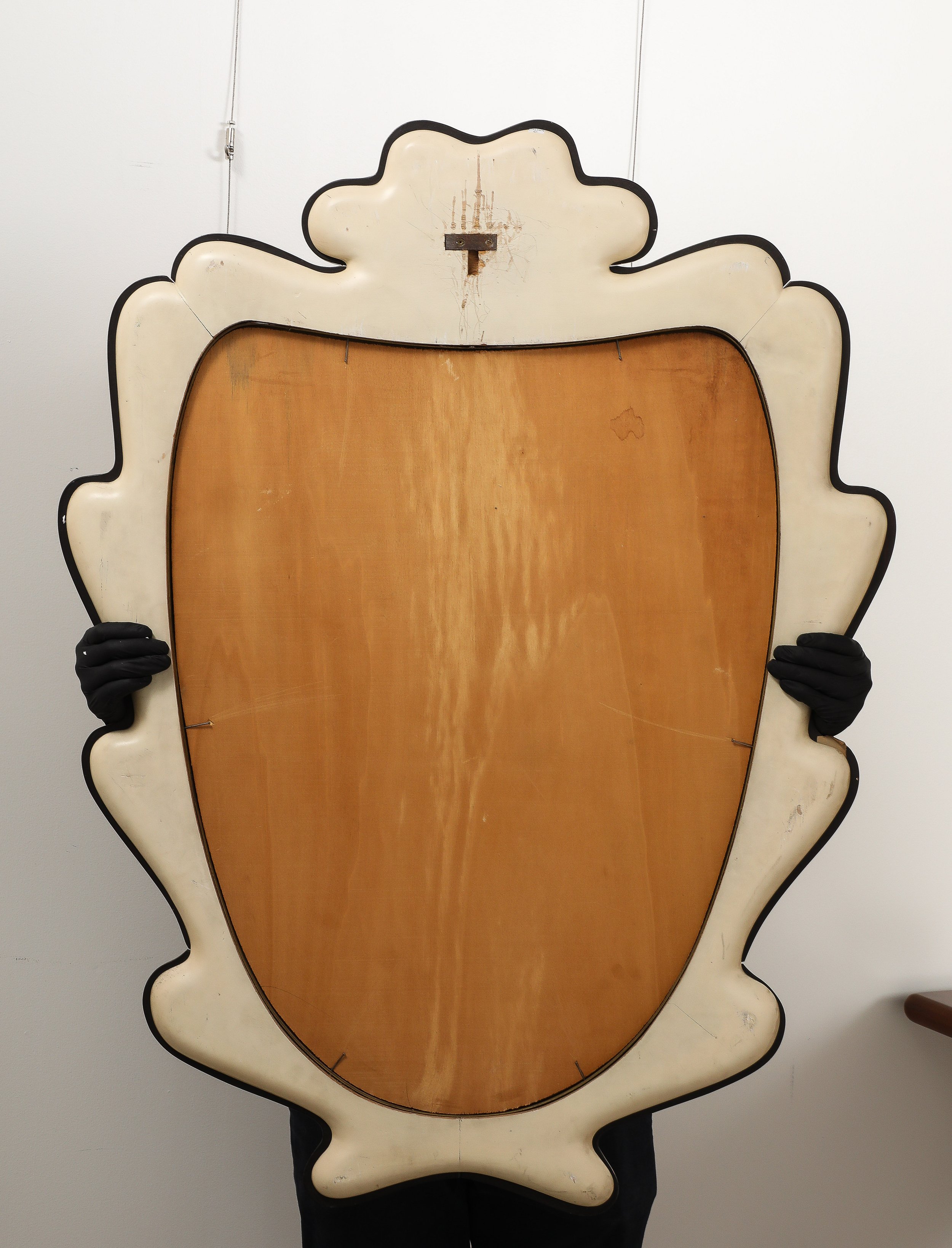 Image 1 of 13
Image 1 of 13

 Image 2 of 13
Image 2 of 13

 Image 3 of 13
Image 3 of 13

 Image 4 of 13
Image 4 of 13

 Image 5 of 13
Image 5 of 13

 Image 6 of 13
Image 6 of 13

 Image 7 of 13
Image 7 of 13

 Image 8 of 13
Image 8 of 13

 Image 9 of 13
Image 9 of 13

 Image 10 of 13
Image 10 of 13

 Image 11 of 13
Image 11 of 13

 Image 12 of 13
Image 12 of 13

 Image 13 of 13
Image 13 of 13














Pietro Chiesa for Fontana Arte Pink Glass and Crystal Mirror, circa 1930
A stunning and grand scale mirror designed by Pietro Chiesa for Fontana Arte, mid 1930's. The mirrored rose/ pink colored glass and crystal frame is decorated with sand jet and geometric motifs. The shaped inner clear glass mirror plate with brass surround. Dramatic in shape and size; this superb mirror is a prime example of the high level of skill and exquisite craftsmanship realized in the Fontana Arte Studio under the artistic direction of Pietro Chiesa in the 1930's.
by Pietro Chiesa for Fontana Arte, mid 1930's.
Size: 42" high x 32 1/4" wide x 1 1/4" deep
Provenance: Private Collection, Milan.
Literature: Similar Examples: F. De Boni, 'Fontana Arte, Gio Ponti, Pietro Chiesa, Max Ingrand' Allemandi, Torino, 2012 Pg. 174-176.
Pietro Chiesa (born 1892, Milan–died 1948, Paris) was a leading Italian Modernist and Art Deco designer best known for his artistic glass furnishing pieces. He belonged to the Swiss Ticino family of artists. He studied at the Accademia di Belle Arti di Brera and then trained as an apprentice at the studio of furniture designer Giovanni Battista Gianotti. In 1921, he opened his own studio in Milan, the Bottega di Pietro Chiesa, and showcased his work at the seminal 1925 Paris Exposition. While running the Bottega di Pietro Chiesa, he also completed some major projects, such as designing and crafting the windows for the Trieste Stock Exchange and those for the ocean liner Conte di Savoia. In 1925, he exhibited his work for the first time at the Exposition Internationale des Arts Décoratifs et Industriels Modernes in Paris.
In 1932, Gio Ponti approached Pietro Chiesa to join him and Luigi Fontana and to become Luigi Fontana SA’s artistic director. During Chiesa’s tenure as artistic director, Fontana Arte’s production became rich and varied. Chiesa created what would become Fontana Arte’s signature colors of the time, deep blue and green, which Chiesa integrated so successfully into many of his creations. It included furniture, tables, mirrors, sculptures, and stained glass, creating the highest standard for glass craftsmanship and modern designs.
A stunning and grand scale mirror designed by Pietro Chiesa for Fontana Arte, mid 1930's. The mirrored rose/ pink colored glass and crystal frame is decorated with sand jet and geometric motifs. The shaped inner clear glass mirror plate with brass surround. Dramatic in shape and size; this superb mirror is a prime example of the high level of skill and exquisite craftsmanship realized in the Fontana Arte Studio under the artistic direction of Pietro Chiesa in the 1930's.
by Pietro Chiesa for Fontana Arte, mid 1930's.
Size: 42" high x 32 1/4" wide x 1 1/4" deep
Provenance: Private Collection, Milan.
Literature: Similar Examples: F. De Boni, 'Fontana Arte, Gio Ponti, Pietro Chiesa, Max Ingrand' Allemandi, Torino, 2012 Pg. 174-176.
Pietro Chiesa (born 1892, Milan–died 1948, Paris) was a leading Italian Modernist and Art Deco designer best known for his artistic glass furnishing pieces. He belonged to the Swiss Ticino family of artists. He studied at the Accademia di Belle Arti di Brera and then trained as an apprentice at the studio of furniture designer Giovanni Battista Gianotti. In 1921, he opened his own studio in Milan, the Bottega di Pietro Chiesa, and showcased his work at the seminal 1925 Paris Exposition. While running the Bottega di Pietro Chiesa, he also completed some major projects, such as designing and crafting the windows for the Trieste Stock Exchange and those for the ocean liner Conte di Savoia. In 1925, he exhibited his work for the first time at the Exposition Internationale des Arts Décoratifs et Industriels Modernes in Paris.
In 1932, Gio Ponti approached Pietro Chiesa to join him and Luigi Fontana and to become Luigi Fontana SA’s artistic director. During Chiesa’s tenure as artistic director, Fontana Arte’s production became rich and varied. Chiesa created what would become Fontana Arte’s signature colors of the time, deep blue and green, which Chiesa integrated so successfully into many of his creations. It included furniture, tables, mirrors, sculptures, and stained glass, creating the highest standard for glass craftsmanship and modern designs.
